

Body of IITR

SPOILER WARNING
The following article contains extensive spoilers for the film ‘Portrait of a Lady on Fire’. Readers are encouraged to watch the movie before they proceed.
Most people love fried bhindi. To some (including Author P), it is the greatest thing on earth, a true delicacy and the most OP vegetable known to humankind. Yet despite repeated testaments to vendakya being the key to infinite intelligence and reassurance that ‘this is just a phase’, Author A dislikes (to say the least) this wretched organism from the depths of their existence. Imagine having your brain sheared off, cutting your fingers off, frying them and then eating them. You don’t need to imagine it, you already have. The only silver lining is that whichever genius decided to name this autotrophic piece of sinew ‘Lady’s finger’ has an imagination equally morbid and has learnt to hide it with subtlety.
The only relevant difference between Author A and Author P is their separate, individual reality. The finger remains the same, yet it receives such varied reactions. Rarely, if ever, do we investigate the working and interactions of our experiences, our senses and our desires. Céline Sciamma’s 2019 masterpiece Portrait of a Lady on Fire deals with these very concepts.
Portrait is a profoundly tender story about self discovery, becoming and the anticipation of coming to terms with being noticed by someone. It spends its time with the characters as they fall in love. Set in the 18th century, this forbidden queer period drama does a lot. We are introduced to Marianne right away, an artist teaching a painting class who notices one of her old (quite possibly secret) works ‘Portrait of a Lady on Fire’. We are then taken back in time through Marianne’s memory.
Amidst the sounds of waves crashing, Marianne arrives on a remote island off the coast of Brittany after the Comtesse commissions her to paint a portrait of her daughter, Héloïse. Héloïse is to marry a Milanese nobleman. Before Marianne’s arrival, Héloïse had already spoiled her mother’s plans to have her portrait painted and sent to Milan for the prospective husband’s appraisal because she refused to sit for a male artist. Now, Marianne has the task of painting Héloïse in secret, while spending time with her in the guise of a walking companion.
Sciamma makes very specific use of camera angles and blocking. For most of the film, the viewer is placed in one of three perspectives - following Marianne from right behind her, watching Héloïse from Marianne’s perspective and wider shots of the characters interacting. While entire essays could be written on how the film deals with the concept of ‘The Gaze” from artistic and feminist perspectives, this technique also provides a third perspective, showing us from both the inside and the outside how a relationship develops.
For the first half of the film, Héloïse just wants to be ‘looked at’, to actually be seen as the person she is, and not just as an imaginary object in a painting. We know nothing about the Milanese nobleman, nor does anyone make any effort to describe him beyond those two words.
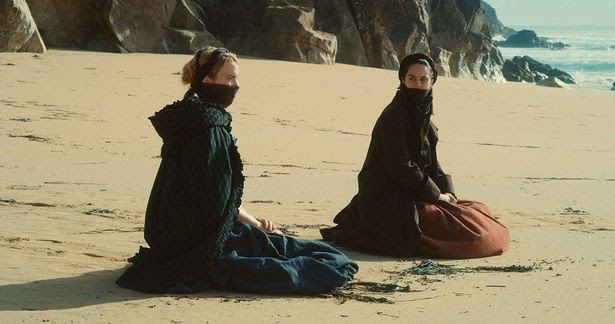
To see someone is not as simple as it is made out to be. One could be very mechanical about it and describe only what is externally apparent - a person’s appearance, their clothes, their actions, their words. This is extremely reductive and impersonal. Any human being could describe any other human being in this way if they were in the same room as them, if they had a photo of them or if they walked past them on a busy street. This is what Marianne does initially. We keep looking at Héloïse’s hands, her hair, her eyes. Marianne’s focus is to draw Héloïse as accurately as possible, which means she needs a smile. She only cares about that expression and not the feelings that trigger it.
On a deeper level, as we are drawn to something, we attempt to learn how it works. Musicians learn music theory and appreciate the intricacies and brilliance of the composition and arrangement when they listen to a new song, beyond merely how it sounds to a lay-person. When it comes to people, we study their desires. To know someone is to know how they think and why they behave a certain way, to know what they want and to predict what they will need. Marianne realises that she is attracted to Héloïse and cannot bear to pretend anymore, even to herself. She realises that she has repeated the previous artist’s behavior and destroys her first portrait out of guilt.
Most people, especially in popular descriptions stop here. But there is a trap - human beings aren’t automatons. We can only guess at the motives of others based on what we see and what they themselves tell us. More importantly, we ourselves do not really know how our minds work. We analyse ourselves based on our own self-image, which is tainted by our biases, experiences and the knowledge that this is our own selves that we are trying to understand. A degree of uncertainty exists. Try taking an online personality test. The result will likely be what you predicted (and is probably not accurate) - the test told you what you think your personality is.
We don’t actually love other people because we don’t really know other people. We love the idea of them, our own mental automaton that thinks and acts like them. The closer the approximation, the healthier the relationship. We are stuck in our bubbles of momentary infatuation and myopic affection.
The film shows us this mind-numbing, suffocatingly exhilarating, early-stage love in the way we stop looking at specific parts of Héloïse and just stare in her general direction. We watch them play the harpsichord together, catching fleeting glimpses of each other from the corners of their eyes. When Héloïse finally agrees to pose for Marianne, we watch from a neutral perspective how the two fawn over each other, barely able to look each other in the eye, yet extremely concerned about the other. Marianne says ‘look at me’, so she herself can get a good look at Héloïse. The camera cuts to Marianne’s perspective exactly as she looks up. We gasp every time.
Marianne and Héloïse’s romance has to end. We know this from the very start. Halfway through the movie, the film makes its engagement with the myth of Orpheus and Eurydice, right when it’s starting to get evident that Marianne and Héloïse have feelings for each other. The dialogue, editing and composition in this scene makes it almost impossible to miss how iconic and relevant the myth is going to be to their story.
Héloïse wonders if maybe it was Eurydice who asked Orpheus to look back - perhaps she played a role in her own end. Marianne thinks differently - “He doesn’t make the lover’s choice, but the poet’s. He chooses the memory of her.” Later, when Marianne and Héloïse are forced to part themselves, neither is without agency - like her imagined version of Eurydice, Héloïse encourages Marianne to look back at her; and like her Orpheus, Marianne chooses not to regret, but to remember.
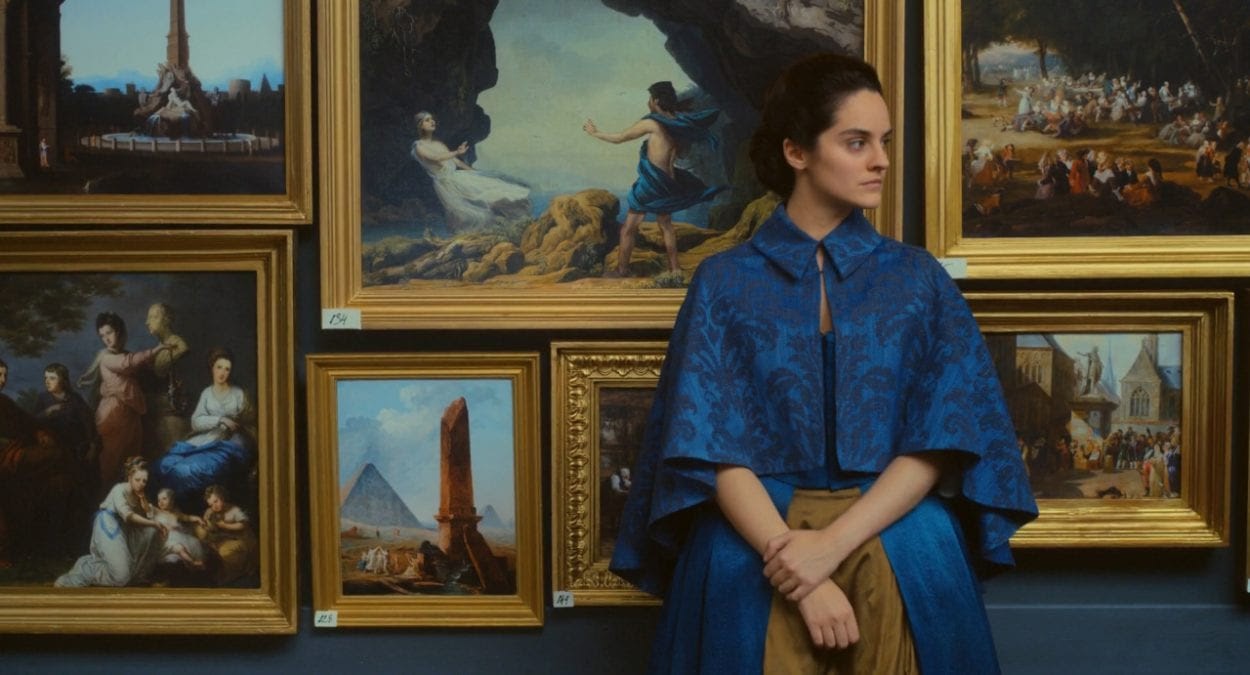
These authors believe that both versions are true. The time Eurydice spent in the underworld and Orpheus spent alone in the human world has resulted in drastic changes in both of them. They are not who they were before and Eurydice realises this. She knows that their relationship is doomed and hell is a pretty comfortable place anyway.
In both stories, the artist in the relationship tries saving their love from “death”, figurative in the case of Héloïse and literal in the case of Eurydice. The artist then “looks back”, losing their lover, keeping with them only the memory of theirs.
The film plays with this idea from the beginning. The first time Marianne meets Héloïse, they go out on a walk with their faces covered. Héloïse makes a run for the cliff with Marianne (and us) fearing that she will jump off and kill herself like her sister, that the film will end before it has even started. But Héloïse stops and uncovers her face. The waves surge and she turns around.
The film’s score is the score of real life. The surging of the waves, the crackle of the fire, the footsteps. Each moment is filled with intention. So when the film actually uses music, the scene’s importance is emphasized automatically.
One of the most powerful scenes in the film features a group of local women chanting in front of a bonfire, producing a scene of community that nurtures the crescendo of desire between Marianne and Héloïse. Its status as a central turning-point is powerfully emphasized by its being one of only three scenes with music: in this case, a haunting acapella chorus that seems to emerge organically from the society of women around the fire. With its harmonies stacking ever higher, and with dynamics rising to match, the song in some way mirrors the flames, literal in the way Héloïse was in flames (which then goes on to inspire the titular painting that we see at the beginning of the movie) and figuratively, the flames igniting between the two characters. Héloïse and Marianne stare at each other, even as one catches fire, even as things change.
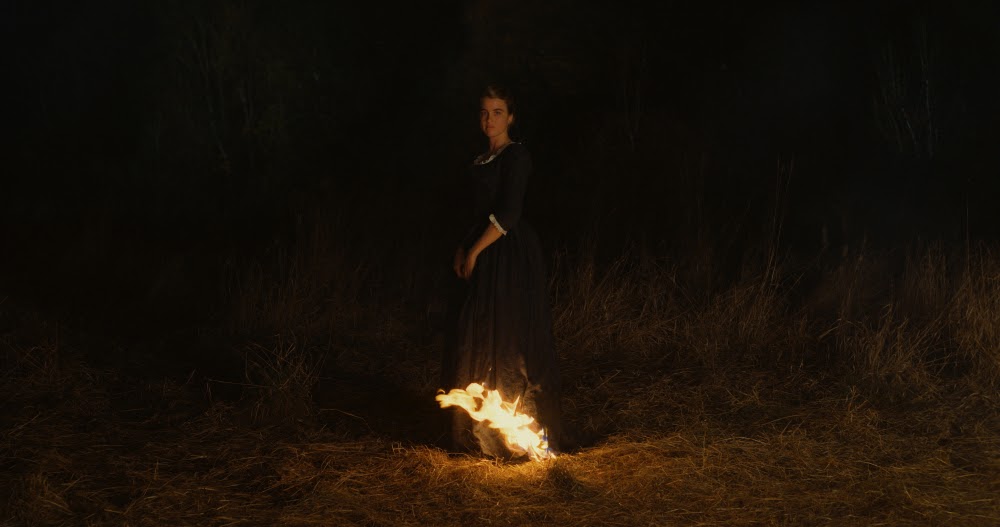
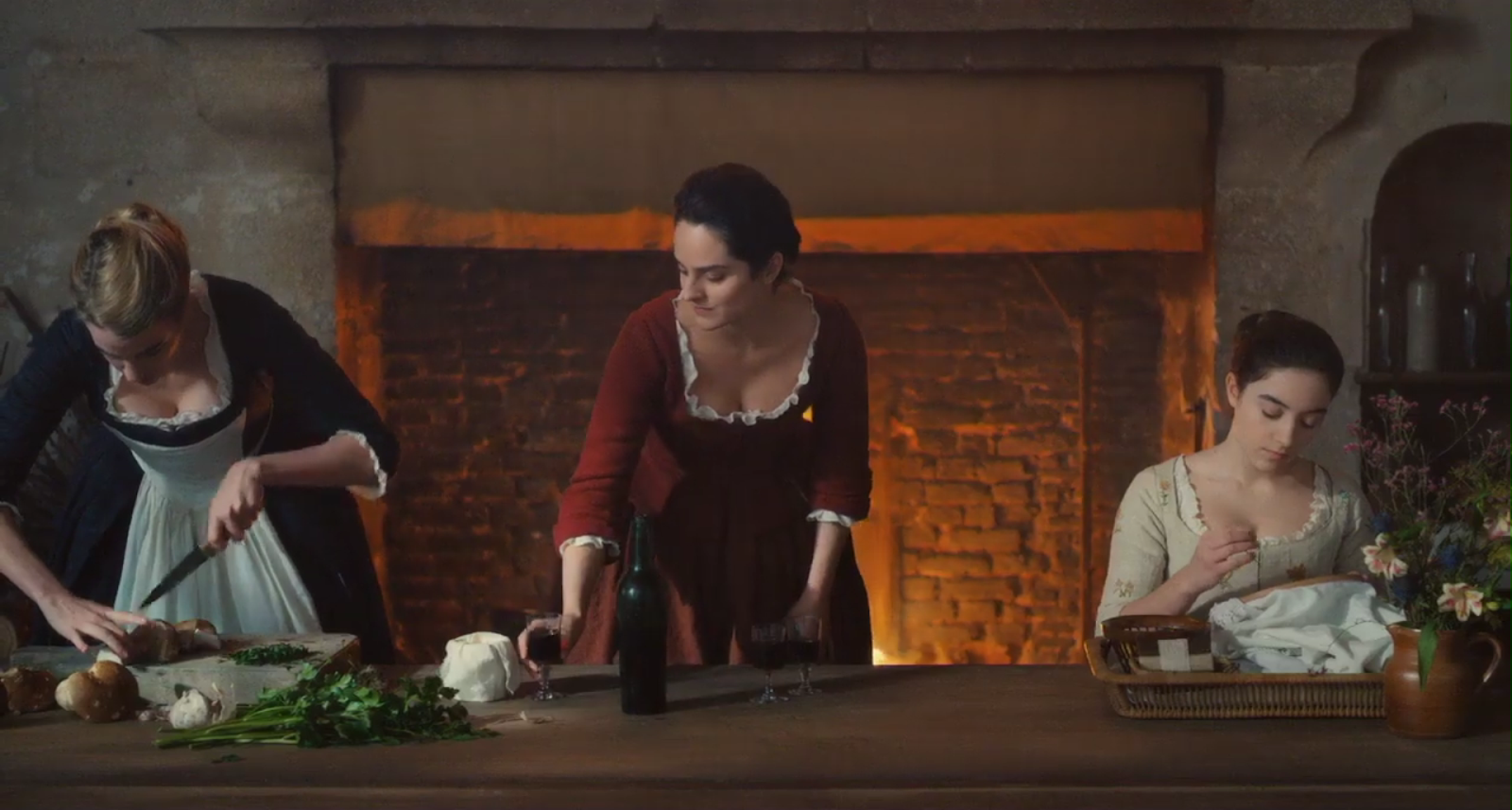
Class divisions also break down as the two form a friendship with the family maid, Sophie, accompanying her to get an abortion from a village medicine woman. Sophie lies on the same bed where the local woman’s infant plays. We see a close up of Sophie’s face, as the infants play with her. We watch as Sophie goes through pain and begins to cry, but the giggling baby next to her makes her smile, comforting her and clinging to her fingers. There is a conscious choice, in this scene, to depict Sophie as neither a demon nor a victim. Later that evening, at Héloïse’s suggestion, the three women re-create and paint Sophie’s abortion, an act that comes across as normal. By choosing to portray it, they deem it important, a story worth telling.
The film shows us all these different women come together, laugh, cry and support each other based on simple commonalities, proximity and good nature. The film also sends out a clear pro-choice message as it points out to us that we should not let out subjective notions cloud objective truths. Héloïse and Marianne care and support Sophie and do all the things that someone who ‘loved’ Sophie would do as well.
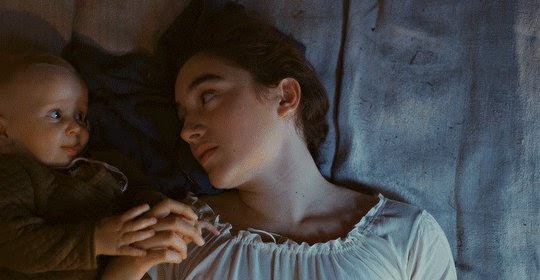
The final scene of the film takes place long after the affair, Héloïse married and with a child. Marianne sees Héloïse, who is unaware of her presence, sitting alone in an opera house, and watches her former lover closely as the orchestra opens with the ‘Summer’ concerto of Antonio Vivaldi’s The Four Seasons – the same piece of music that Marianne had played for Héloïse years ago on a harpsichord. Marianne remains fixed unflinchingly on Héloïse as she listens raptly, a wrenching sequence of expressions registering on her face, emotions heightened. Both women still remember those experiences and have feelings for the person they knew.
What makes this final shot of Héloïse so masterful is that it is from Marianne’s perspective. This is a movie which explores the power of observation, of appreciation for the subtleties of expression which make you appreciate the object of your desire that much more, telling us what desire and love and friendship could mean for women, when free from society’s patriarchy, even for a short period of time. Portrait is a memory of a love story; sad yet hopeful.
Even though this idea of perception, the idea of it being not one sided is nothing short of terrifying, at the end of the day, all we think we still want is someone to whom we can say ‘Look at me.”
Attached for your listening, here’s a list of songs that we associate with the film.
https://open.spotify.com/playlist/04n1zPULrTqPPWFQL6Rswn?si=TA7o53oqS-auQu2HDk-p0Q
Miscellaneous
What Portrait of a Lady on Fire Tells Us About “the Gaze”
Portrait of a Lady on Fire review – mesmerised by the female gaze